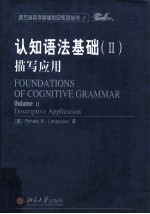图书介绍
认知语法基础 2 描写应用2025|PDF|Epub|mobi|kindle电子书版本百度云盘下载

- (美)Ronald W.Langacker著 著
- 出版社: 北京:北京大学出版社
- ISBN:7301076940
- 出版时间:2004
- 标注页数:591页
- 文件大小:267MB
- 文件页数:623页
- 主题词:语法学-英文
PDF下载
下载说明
认知语法基础 2 描写应用PDF格式电子书版下载
下载的文件为RAR压缩包。需要使用解压软件进行解压得到PDF格式图书。建议使用BT下载工具Free Download Manager进行下载,简称FDM(免费,没有广告,支持多平台)。本站资源全部打包为BT种子。所以需要使用专业的BT下载软件进行下载。如BitComet qBittorrent uTorrent等BT下载工具。迅雷目前由于本站不是热门资源。不推荐使用!后期资源热门了。安装了迅雷也可以迅雷进行下载!
(文件页数 要大于 标注页数,上中下等多册电子书除外)
注意:本站所有压缩包均有解压码: 点击下载压缩包解压工具
图书目录
Review and Introduction1
PART Ⅰ:NOMINAL STRUCTURE13
Chapter 1—Nonus13
1.1.Conceptual Basis13
1.1.1.A Cognitive Model13
1.1.2.An Abstract Characterization15
1.1.3.A Polar Opposition19
1.2.Nominalization22
1.2.1.Kinds23
1.2.1.1.Alternate Profiling23
1.2.1.2.Type vs.Instance Nominalizations31
1.2.2.Periphrasis35
1.2.3.Predictability43
Chapter 2—Nominals:Functional Organization51
2.1.Semantic Functions51
2.2.Instantiation55
2.2.1.Type vs.Instance55
2.2.2.Proper Names58
2.2.3.Type Hierarchies60
2.2.4.Predicate Nominative Constructions64
2.2.5.Role Specifications71
2.3.Quantity73
2.3.1.Number74
2.3.2.Quantifiers81
2.4.Epistemic Predications89
Chapter 3—Nominals:Grounding and Quantification96
3.1.Definiteness96
3.1.1.The Definite Article97
3.1.2.The Indefinite Article103
3.2.Relative Quantifiers107
3.2.1.Proportional Quantifiers107
3.2.2.Other Universal Quantifiers111
3.3.Quantificational Interactions118
3.3.1.Replicate Processes and Participants118
3.3.2.Quantifier Scope125
3.3.3.Scope of Negation132
Chapter 4—Nominal Constructions142
4.1.Structural Organization142
4.1.1.Canonical Structure142
4.1.2.Other Configurations148
4.2.Patterns and Restrictions152
4.2.1.Class Schemas152
4.2.2.Constructional Schemas156
4.2.3.Larger Configurations159
4.3.Functional Alternatives163
4.3.1.Noun Classifiers164
4.3.2.Possessive Constructions167
4.3.2.1.Abstract Possession169
4.3.2.2.Basic Constructions172
4.3.2.3.Other Constructions175
4.4.Inflection and Agreement180
4.4.1.Noun Classes180
4.4.2.Gender Inflections185
4.4.3.Agreement Patterns186
PART Ⅱ:CLAUSE STRUCTURE193
Chapter 5—The Auxiliary:Clausal Head193
5.1.Function and Organization193
5.2.Voice and Aspect200
5.2.1.The Passive Construction200
5.2.2.The Progressive Construction207
5.2.3.The Perfect Construction211
5.2.3.1.Current Relevance211
5.2.3.2.Subjectification215
5.2.3.3.Synthesis220
5.3.Patterns and Structure225
5.3.1.The Basic System225
5.3.2.Restrictions228
5.3.3.Componentiality233
5.3.4.Auxiliary Verbs238
Chapter 6—The Auxiliary:Grounding240
6.1.Epistemic Distance240
6.2.Tense249
6.2.1.A Naive Characterization250
6.2.2.Sequence of Tenses253
6.2.2.1.Indirect Speech253
6.2.2.2.Reported Modals256
6.2.2.3.Additional Matters260
6.2.3.Present Tense262
6.2.3.1.A Structured World263
6.2.3.2.A Shifted Deictic Center266
6.3.Modals269
6.3.1.Historical Development269
6.3.2.The Dynamic Evolutionary Model275
Chapter 7—Transitivity and Grammatical Relations282
7.1.The Conception of Events282
7.1.1.Models and Archetypes283
7.1.2.Conceptual Autonomy286
7.1.3.Starting Points291
7.2.The Coding of Events293
7.2.1.Coding and Construal294
7.2.2.Unmarked Coding298
7.3.Basic Grammatical Relations304
7.3.1.Subject305
7.3.1.1.Topicality306
7.3.1.2.A Schematic Definition309
7.3.1.3.Subjectand Topic313
7.3.1.4.Universality317
7.3.2.Direct Object321
7.3.3.Indirect Object324
Chapter 8—Marked Clause Structure330
8.1.Choice of Subject330
8.1.1.The Effect of Profiling331
8.1.2.Voice335
8.1.3.Setting vs.Participant343
8.1.3.1.Relevance to Transitivity343
8.1.3.2.Setting-Subject Constructions345
8.1.3.3.Double-Subject Constructions348
8.1.3.4.Abstract Settings351
8.2.Choice of Object355
8.3.Nondistinct Argument Phenomena362
8.3.1.Process vs.Participant362
8.3.2.Reflexivization367
8.3.3.Unspecificity372
Chapter 9—Ergativity and Case378
9.1.Ergative vs.Accusative378
9.2.Ergativity386
9.2.1.Correlates of Autonomy386
9.2.2.Absolute Construal389
9.2.3.Discourse Function393
9.2.3.1.Introducing Discourse Participants393
9.2.3.2.Antipassives394
9.2.4.Split Ergativity396
9.3.Case Marking398
9.3.1.Meaningfulness398
9.3.2.Case-Marking Constructions404
9.4.Causative Constructions408
9.4.1.Grammatical Relauons409
9.4.2.Case411
PART Ⅲ:BEYOND THE CLAUSE417
Chapter 10—Complex Sentences417
10.1.General Discussion417
10.1.1.Internal Elaboration419
10.1.2.Connectors423
10.1.3.Referential Linkage429
10.1.4.Global Organization435
10.2.Complementation438
10.2.1.Complementizers439
10.2.1.1.Conceptual Subordination439
10.2.1.2.Temporal Coincidence442
10.2.1.3.Objectivity445
10.2.2.Raising449
10.2.2.1.Critique450
10.2.2.2.The Active-Zone Analysis453
10.2.2.3.Raising vs.Equi457
Chapter 11—Further Issues464
11.1.Rule Interactions464
11.2.Coordination472
11.2.1.Conjunctions472
11.2.2.Level of Coordination476
11.2.3.Differentiation of Conjuncts479
11.2.4.Phonological Coinstantiation485
11.3.Anaphora490
11.4.Speech Acts494
11.4.1.Domains and Organization495
11.4.2.Viewing Arrangements498
11.4.3.Basic Sentence Types503
Chapter 12—Theoretical Discussion507
12.1.Metaphors,Goals,and Expectations507
12.2.The Autonomy Issue514
12.2.1.Defining the Issue515
12.2.2.Assessing the Symbolic Alternative520
12.3.Processing,Rules,and Representations525
12.3.1.The Connectionist Alternative526
12.3.2.The Representation of Linguistic Structure528
12.3.2.1.A Spectrum of Positions528
12.3.2.2.The Nature of Linguistic Rules533
Conclusion and Prospectus537
REFERENCE MATTER543
Glossary543
References557
Index575
热门推荐
- 1909810.html
- 22805.html
- 341732.html
- 1788036.html
- 2572296.html
- 1638635.html
- 3827753.html
- 2094964.html
- 2882031.html
- 2248174.html
- http://www.ickdjs.cc/book_1059376.html
- http://www.ickdjs.cc/book_254388.html
- http://www.ickdjs.cc/book_2886802.html
- http://www.ickdjs.cc/book_730280.html
- http://www.ickdjs.cc/book_855887.html
- http://www.ickdjs.cc/book_2564288.html
- http://www.ickdjs.cc/book_2152242.html
- http://www.ickdjs.cc/book_300324.html
- http://www.ickdjs.cc/book_1700423.html
- http://www.ickdjs.cc/book_1003255.html